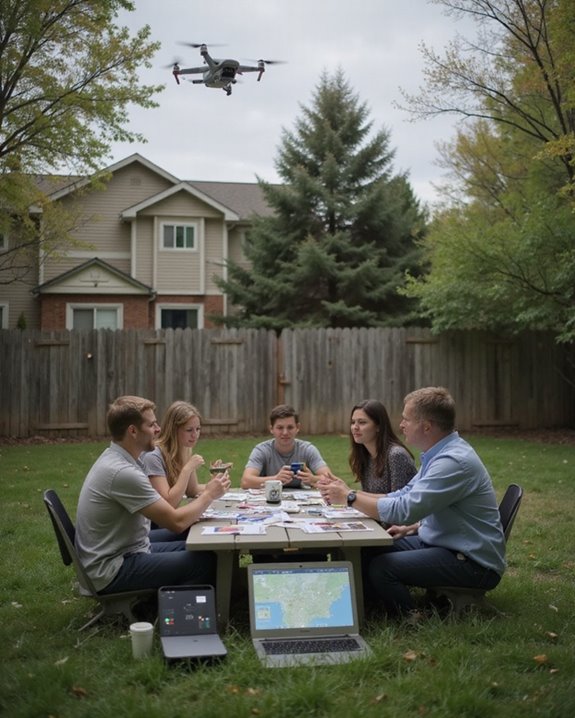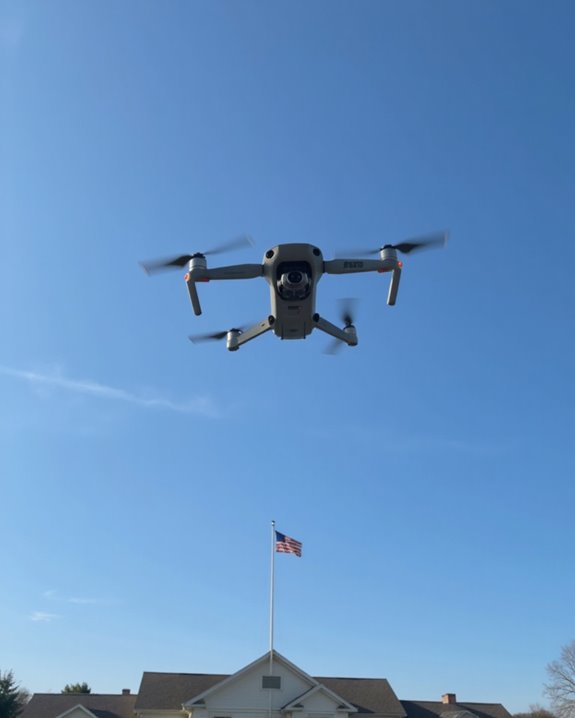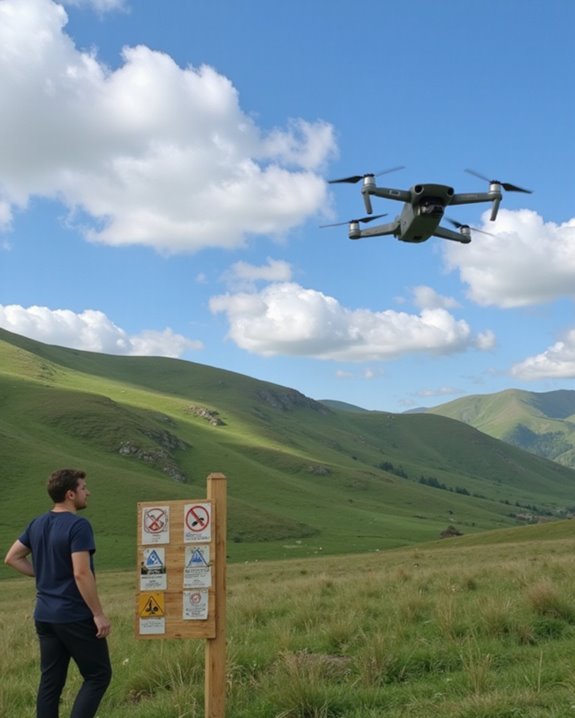Legally taking down drones is highly restricted. Homeowners cannot shoot down or jam drones over their property, as this violates federal aviation laws with serious penalties. Instead, your best options include contacting local law enforcement immediately, documenting intrusions with photos and details, and implementing privacy measures like strategic landscaping or window films. Government agencies have special authorization to use methods like drone nets, but civilians don’t! The detailed guide below explores each lawful approach to handling unwanted aerial visitors.
Key Takeaways
- Contact local law enforcement immediately when unwanted drones appear over your property.
- Document drone appearances with photos, timestamps, and flight patterns as evidence for authorities.
- Install physical privacy measures like tall fences, mature trees, and outdoor canopies.
- Understand that destroying or jamming drones is illegal under FAA and FCC regulations.
- Only authorized government agencies can legally disable drones using specialized equipment like nets.
Understanding Your Legal Rights and Limitations
When homeowners spot a drone hovering over their backyard, their first instinct might be to grab something to knock it out of the sky, but understanding the legal framework around drone interference is absolutely critical! Despite feeling like an invasion of privacy, recent Judicial Rulings have consistently upheld that property owners cannot legally shoot down or disable drones—even ones flying directly over their land.
The FAA considers drones as aircraft, and damaging them can result in federal charges, hefty fines, or even jail time! Statutory Limits clearly establish that airspace regulation falls under federal jurisdiction, not homeowner authority. While your frustration is completely understandable (who wants uninvited eyes peering into their yard?), taking matters into your own hands could land you in more trouble than the drone operator! Using FCC regulations to actively jam or interfere with drone signals is illegal and can incur significant penalties.
Authorized Methods for Drone Disruption
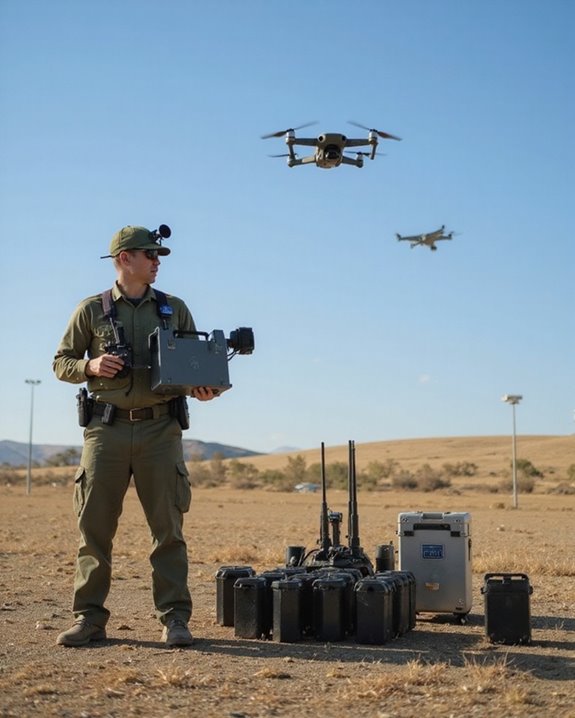
While homeowners can’t legally disable drones themselves, certain government agencies actually possess legal authority to take down these flying devices! The Department of Defense, Justice, and Homeland Security have explicit powers to detect, track, and even destroy threatening drones over specific protected sites.
These agencies employ several methods that regular citizens cannot. Drone Nets are among the safest options, allowing for capture without creating dangerous falling debris. Some agencies are also developing Directed Energy Weapons that can disable drones without destruction, though these remain highly regulated. Professional drone capture systems often use CO2-powered net launchers to balance portability and effectiveness in safely capturing drones.
Working With Law Enforcement and Regulatory Agencies
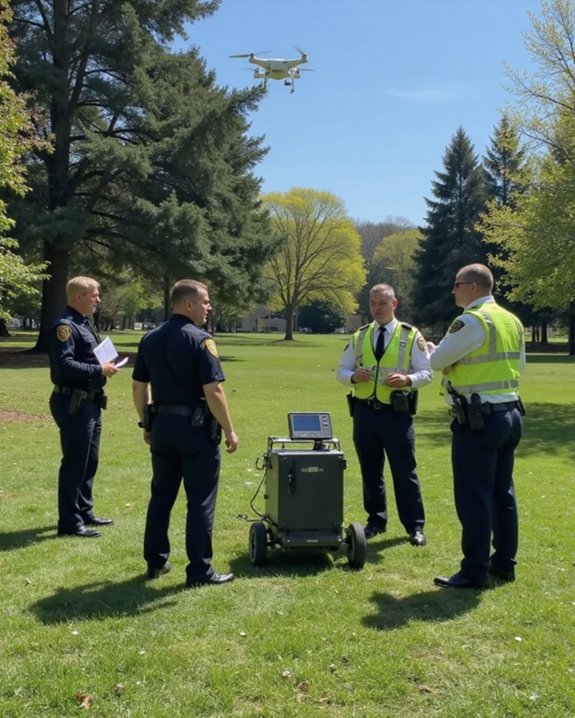
How exactly should homeowners respond when they spot an unwanted drone hovering above their property? The first step is always to contact local law enforcement rather than taking matters into your own hands! When officers arrive, be ready to provide detailed information about the drone’s appearance, flight pattern, and duration of presence.
Many police departments now participate in Interagency Partnerships with the FAA, allowing for more efficient handling of drone complaints. Some communities even host Regulatory Workshops where residents can learn about drone laws and proper reporting procedures. Additionally, understanding the importance of Remote ID compliance can aid in identifying drones and supporting law enforcement efforts.
Preventative Measures to Protect Your Privacy

Rather than waiting until an unwanted drone appears in your airspace, homeowners can implement several preventative strategies to safeguard their privacy before issues arise. Installing tall Fence Barriers around property perimeters creates a physical and legal boundary that drone operators must respect. These structures, when properly designed, can block low-flying devices without violating height restrictions!
Privacy Screening options include strategic landscaping with mature trees, pergolas with climbing vines, or retractable canopies that shield outdoor living spaces from aerial view. Many homeowners combine these approaches with tinted windows or specialized window films that prevent camera penetration while maintaining natural light.
Documentation and Evidence Collection Strategies
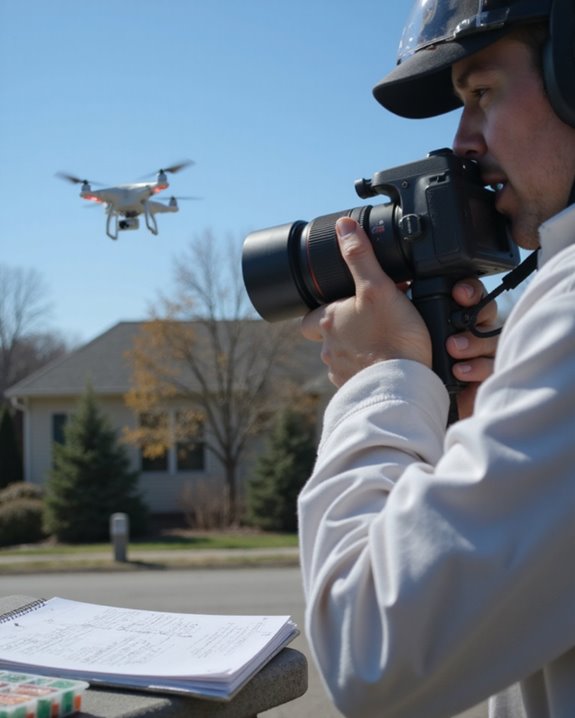
When a drone hovers suspiciously over your property, gathering proper documentation becomes your most powerful legal weapon! Establishing a solid evidence trail starts with recording exactly when and where the drone appeared, along with any distinctive features you can spot from the ground.
Witness statements provide vital corroboration – ask neighbors or visitors to describe what they observed, and have them sign dated accounts. Photo evidence is absolutely worth the effort, too! Snap clear images of the drone showing its size, color, and any identifying markings, if possible.
Remember to use standardized documentation formats for consistency, and maintain a secure chain of custody for all evidence collected. These details might seem tedious, but they’re exactly what authorities need to take your case seriously and pursue appropriate legal action!
Frequently Asked Questions
Can I Sue a Drone Operator for Invasion of Privacy?
Individuals can sue drone operators for invasion of privacy under various privacy laws. Success depends on establishing reasonable expectations of privacy and effective evidence gathering that demonstrates unauthorized surveillance of private activities.
Are There Drone-Free Zones Where Takedowns Are More Permissible?
Powerful precedents prevail in specific areas. Zone legislation near airports, military facilities, and wildlife protections may permit authorities—not civilians—to take action against drones. However, takedown authorization still requires proper legal channels in most jurisdictions.
Do Homeowner Insurance Policies Cover Damage Caused by Drones?
Homeowner policies typically cover damage caused by drones, including insurance claims for property damage or bodily injury. Coverage limits and deductibles apply, and specific exclusions may exist depending on individual policy terms.
How Close Can a Drone Legally Fly to My Property?
Drones demarcated by distance can legally fly over private property at any proximity horizontally. Altitude regulations typically restrict operation to 400 feet above ground level, though local ordinances in some areas may require greater distances from structures.
Can I Request Temporary No-Fly Zones During Special Events?
For private events, individuals cannot directly request TFRs. Event planners must coordinate with local authorities who may engage the FAA. Festival regulations often require following established protocols for temporary airspace restrictions rather than individual requests.

